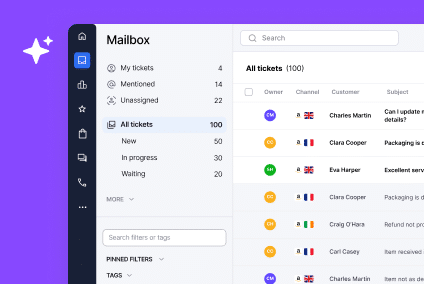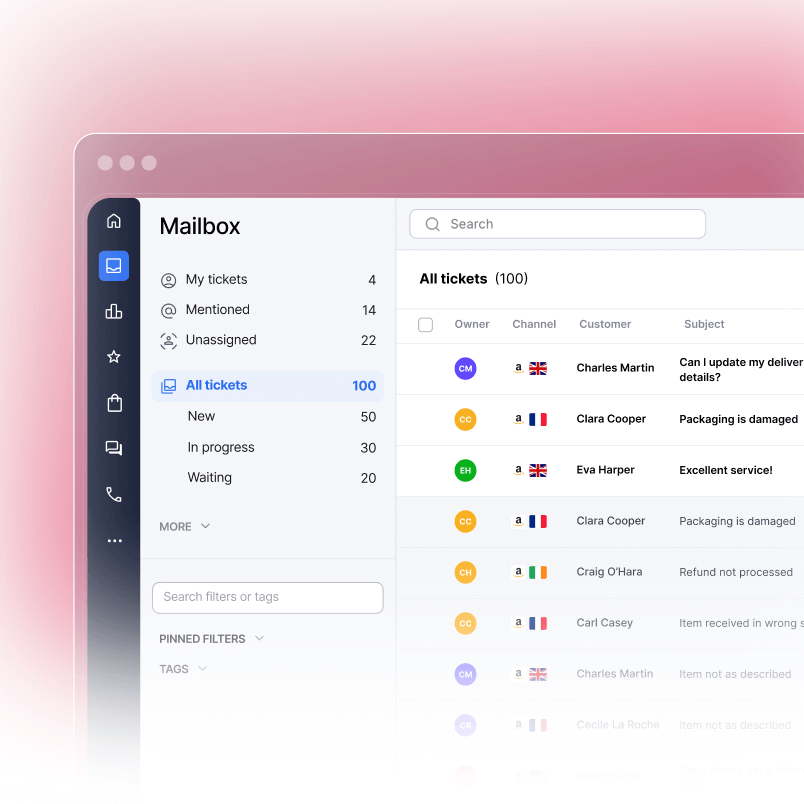Your customer just bought something at 2 AM with a question about shipping. By 8 AM, they’re frustrated because nobody answered. By noon, they’ve left a bad review. Sound familiar?
This is where the right eCommerce helpdesk software becomes your lifeline. We’ve seen businesses lose revenue not because their products were bad, but because their support was too slow or scattered across too many tools.
The question isn’t whether you need helpdesk software. It’s which features will actually move the needle for your business. Not all eCommerce helpdesk solutions work the same way. Some focus on speed. Others prioritize integration. A few do both.
In this guide, we’ll break down exactly what to look for so you can choose a platform that matches your business needs, not just a generic solution.
Multichannel Support Capabilities
Your customers don’t shop from one place. They browse on Instagram, ask questions via email, buy on your website, and follow up on Facebook. Your helpdesk software needs to handle all of these channels in one place.
What multichannel support means for eCommerce
Multichannel support means incoming messages from email, chat, social media, SMS, and phone all land in one unified inbox. Your team doesn’t juggle five different apps. Customers get faster responses because nothing falls through the cracks.
Without this, someone sends a message on Facebook, another person checks email separately, and nobody knows what the other channel just promised. Chaos follows quickly.
Which channels matter most for your store
Different eCommerce businesses prioritize different channels. A fashion brand might live on Instagram. A B2B supplier might need phone support. A SaaS company integrated into Shopify would prioritize live chat.
Look for helpdesk software that covers the channels your customers use most. Don’t pay for channels you won’t use. Some platforms charge per channel. Others bundle them. Compare what you actually need.
How to evaluate channel performance
The best eCommerce helpdesk platforms show you response times and resolution rates by channel. Top-performing companies respond within 2 minutes. You’ll see whether email support is lagging behind chat. Maybe phone support has the highest customer satisfaction. Data tells you where to invest support resources next.
Ticketing System and Workflow Automation
A ticket is basically a record of a customer issue from start to finish. When tickets are organized and automated, your team handles more requests in less time.
Core ticketing features to prioritize
Your helpdesk needs automatic ticket creation from all channels. When a customer emails, texts, or DMs, a ticket appears instantly. Tickets should have clear status tracking: open, pending, resolved, closed. You should see who’s working on what and when something’s overdue.
Priority levels matter. An urgent order cancellation isn’t the same as a general product question. Higher-priority tickets should rise to the top of your queue automatically.
Automation that saves real time
Automation in eCommerce helpdesk software handles repetitive work. An order status inquiry gets an instant automated response with tracking information. A refund request triggers an automatic escalation to the right department. A customer follows up after 48 hours without response, so the ticket bumps to urgent.
Set these automations once, then let them run. Your team stops wasting time on tasks that software handles better.
Customizing workflows for your business
Not every business uses the same support process. A marketplace might need approval workflows. A subscription service might need billing escalations. Your eCommerce helpdesk software should let you build custom workflows that match how your team actually works.
Rigid systems force you to bend your processes. Flexible systems let you keep what’s working.
Knowledge Base and Self-Service Options
A self-service knowledge base means customers find answers without contacting you. This is powerful for eCommerce because shipping questions, return policies, and product details are predictable.
Why self-service reduces your support load
When customers find answers themselves, your support team shifts focus to complex, high-value issues. This frees up your agents to handle situations that truly need human expertise. Your team processes more tickets without adding headcount, which directly impacts your bottom line.
Self-service portals let customers resolve issues independently, which reduces the overall volume of support requests your team must handle. This natural decrease in ticket volume means your existing team can work more efficiently and spend their time on problems that matter most.
Building an effective knowledge base
Your eCommerce helpdesk should include a knowledge base builder with search functionality. Customers should find articles easily. The interface needs to be clean and organized by topic. 91% of customers would use a knowledge base if tailored to their needs. 26% improvement in first-contact resolution comes from knowledge bases.
A searchable knowledge base beats a buried FAQ page. Customers spend less time hunting. They get faster answers. Support tickets decrease.
Customer portals and self-service ticketing
The best eCommerce helpdesk platforms offer customer portals. Customers log in, check their ticket status, browse knowledge articles, and submit new requests without emailing. This reduces inbound volume and gives customers control.
A portal also reduces follow-up emails like “Where is my ticket?” because customers see the status in real time.
Integration with Your Existing Tools
Your eCommerce helpdesk doesn’t work in isolation. It needs to connect with your store, payment processor, shipping tools, and other software you’re using.
eCommerce platform integrations
If you run Shopify, BigCommerce, WooCommerce, or any other platform, your helpdesk software should integrate deeply. This means pulling order data, customer history, and product information directly into support tickets.
When a customer emails with a refund request, your support agent sees the order, payment status, and purchase history without leaving the helpdesk. This context means faster, smarter responses.
Essential third-party integrations
Look for integrations with tools you actually use. Payment processors like Stripe or PayPal. Shipping carriers like UPS and FedEx. Email marketing platforms like Mailchimp. CRM tools. Project management software. The more your helpdesk talks to your other tools, the less manual work your team does.
API access for custom integrations
If the eCommerce helpdesk software doesn’t have a native integration you need, look for robust API access. Some businesses have custom tools or unique workflows. A strong API lets you build the integration yourself or hire someone to do it.
Customer Data and Context
Context is everything in support. When you know a customer’s history, preferences, and recent purchases, you solve issues faster and more personally.
Centralized customer profiles
The best eCommerce helpdesk software maintains a complete customer profile. This includes contact information, purchase history, previous support tickets, and preferences. When any team member opens that customer’s ticket, they see everything.
New support agents don’t repeat questions. Customers feel known. Issues get resolved in fewer steps.
Real-time customer data from your store
Your helpdesk should pull live data from your eCommerce platform. Current cart contents, recent browsing behavior, loyalty program status, and subscription details all matter. A customer complaining about a discount might already qualify for one through your system.
Real-time data means your support team makes smarter decisions immediately.
Communication history across all touchpoints
Track every conversation a customer has with your business. Not just support tickets, but emails, chat logs, and social messages. This unified communication history prevents customers from repeating themselves or getting conflicting answers.
Reporting and Performance Metrics
You can’t improve what you don’t measure. The right eCommerce helpdesk software shows you exactly how your support team performs.
Key metrics that matter
Track first response time (how fast you first reply), resolution time (how long to solve the issue), customer satisfaction scores, and ticket volume by channel. These metrics reveal bottlenecks. Maybe chat responses are slow. Maybe email resolution takes too long. Data shows you where to focus training or hiring.
21% want immediate resolution, 23% expect within one hour, and 23% within 1-3 hours. Response times directly impact customer satisfaction and are the number one complaint in eCommerce support.
Custom dashboards and reports
Don’t settle for generic reports. Your eCommerce helpdesk should let you build custom dashboards. Maybe you want to track performance by team member, by product category, or by customer segment. Custom reports mean you see metrics that matter to your specific business.
Some platforms offer scheduled reports that land in your inbox weekly or monthly.
Benchmarking against industry standards
Understanding your metrics is easier when you compare to industry standards. Some eCommerce helpdesk platforms share benchmarks so you see how your response times and resolution rates compare to similar-sized businesses.
This context helps you set realistic improvement targets.
Team Collaboration Features
Your support team works together. The helpdesk software should make that collaboration smooth, not clunky.
Internal notes and ticket comments
Support agents need to communicate about tickets without the customer seeing internal discussion. Robust internal note features let team members share context, ask questions, and hand off tickets smoothly.
Maybe one agent handles first contact, then passes to a specialist. That specialist needs to see what the first agent learned. Internal notes capture that knowledge transfer.
Assignments and workload management
The eCommerce helpdesk should show who’s handling what. Assignment rules automatically route tickets to the right person based on skills, availability, or category. Your best billing expert gets billing escalations. Your shipping specialist handles logistics questions.
Workload management prevents burnout. Overloaded team members get reassigned. New agents get gradually ramped up.
Knowledge sharing and team resources
When one agent learns something useful, the whole team should benefit. Built-in wikis, shared templates, and training resources keep everyone aligned. New team members onboard faster. Mistakes happen less often. Support quality improves across the board.
Scalability and Growth
Your eCommerce helpdesk needs to grow with your business. What works for 100 support tickets monthly might break at 10,000.
Handling increasing ticket volume
As your business scales, ticket volume increases. Your eCommerce helpdesk software should handle that growth without slowing down. Response times shouldn’t degrade. Search shouldn’t become sluggish. The system should stay reliable whether you process 500 or 50,000 tickets monthly.
Adding team members without friction
Scaling your support team should be easy. Adding new agents shouldn’t require expensive per-seat licensing that makes growth prohibitively expensive. Look for transparent pricing that scales linearly with your team size.
New features and updates as you evolve
Your needs change as your business matures. A startup might prioritize speed. A growing company needs advanced reporting. An enterprise needs custom workflows. Your eCommerce helpdesk should offer features you’ll grow into, not force you to switch platforms as needs evolve.
Security and Compliance
Customer data is sensitive. Your helpdesk software handles emails, order information, payment details, and personal information. Security matters.
Data encryption and storage
Your eCommerce helpdesk should encrypt data in transit and at rest. Backups should be automated and redundant. Look for platforms that explicitly state their encryption standards and backup procedures.
Compliance certifications
If you handle certain types of customer data, compliance requirements might apply. GDPR for European customers. CCPA for California residents. PCI DSS if you handle payment information. Your helpdesk software should support compliance efforts through features like data retention policies and user permission controls.
Access controls and permissions
Not every team member needs access to everything. Your eCommerce helpdesk should let you set granular permissions. New agents might see only assigned tickets. Managers see everything. Finance sees payment-related data. Permissions prevent mistakes and protect sensitive information.
Choosing Your Solution
You’ve reviewed features. Now comes the practical decision: how do you pick the right eCommerce helpdesk software for your business?
Audit your current pain points
Start with what hurts today. Are tickets getting lost between channels? Is your team duplicating work? Are customers waiting too long? Are you manually pulling data from multiple systems? Your biggest pain points guide feature priorities.
Test with a free trial
Most eCommerce helpdesk platforms offer free trials. Use them. Create test tickets. Invite your team to try the interface. See if integrations work as promised. A 14-day trial beats months of second-guessing after purchase.
Calculate total cost of ownership
Compare not just monthly price but total impact. A cheaper platform that requires manual workarounds might cost more in team time. A pricier platform with better automation might save you a full-time hire. Factor in implementation time and training. Calculate your actual cost, not just the subscription fee.
Plan for the next 18 months
Choose a platform that handles your growth. If you plan to hire three support agents next year, your software should scale comfortably. If you’re planning a site redesign, check if your helpdesk integrates with your new platform. Don’t optimize for today at the expense of tomorrow.
Your eCommerce helpdesk software is an investment in customer satisfaction. The right platform handles growth, prevents missed tickets, automates repetitive work, and keeps your team organized. Start your free trial today and see how better support changes your business.
FAQs
What’s the difference between helpdesk software and live chat software?
Helpdesk software is a full support management system that handles ticketing, multichannel communication, customer data, and reporting. Live chat is one support channel. Many eCommerce businesses use both. Helpdesk software manages the backend; live chat might be one channel within that system.
How much does eCommerce helpdesk software cost?
Pricing varies widely. Some platforms charge $50 per month for basic features. Others charge $300 or more per agent. Many use per-agent pricing, so costs scale with your team size. Budget $100 to $500 monthly for a small business, depending on features and team size.
Can helpdesk software reduce my support costs?
Yes. Automation reduces the time spent on repetitive tasks. Self-service knowledge bases reduce ticket volume. Better organization means your team handles more issues in the same time. Typically, businesses see 20% to 40% productivity improvements after switching to dedicated helpdesk software.
Which eCommerce platforms integrate best with helpdesk software?
Most major platforms integrate well. Shopify has native integrations with dozens of helpdesk solutions. BigCommerce offers similar options. WooCommerce works with most platforms through APIs or plugins. Check specific integrations before committing to a platform.
Should we implement helpdesk software before or after hiring support staff?
Implement software before scaling your team. Better software lets each team member handle more work. Starting with the right system prevents chaos when you add people. It’s easier to onboard new agents onto good software than to switch systems later.
What features matter most for my type of eCommerce business?
That depends on your specific situation. High-volume, low-complexity stores prioritize speed and automation. Niche businesses with complex orders prioritize knowledge base and team collaboration. B2B stores need strong integration and custom workflows. Identify your biggest pain point and choose features that solve it.




